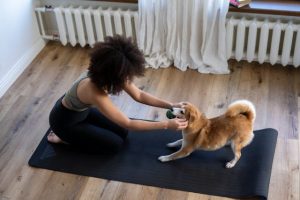How to Help Your Dog Adjust to a New Home. Moving to a new home is exciting, but if you’re a dog owner like me, you probably worry about how your furry friend will handle the change. Dogs thrive on routine and familiar surroundings, so a new environment can be overwhelming. When I moved with my dog, it wasn’t all smooth sailing. But with patience, preparation, and a few handy tricks, we made the transition together—and so can you!
In this post, I’ll walk you through some simple tips to help your dog adjust to their new home. Whether you’ve just moved across town or to a new state, these steps will help your dog feel comfortable and safe in their new environment.
Preparing for the Move
Familiarize Your Dog with the New Environment
If you’re lucky enough to have the option, take your dog for a visit to the new house before moving day. Let them sniff around and explore. Even if it’s just a short walk around the yard or inside the rooms, these early interactions can help your dog feel less anxious when you officially move in. My dog was hesitant at first, but the familiar scents made her feel more secure when we moved for good.
Keep Their Routine Stable
Dogs are creatures of habit, so any sudden change can throw them off balance. During the chaos of packing and preparing, try to maintain their usual routine. Feed them at the same time, take them on their regular walks, and make sure playtime doesn’t get lost in the shuffle. Trust me, I know it can be hard when you’re knee-deep in boxes, but keeping things predictable will reassure them that everything is still okay.
Set Up a Safe Space Before Arrival
This was a lifesaver when I moved! Before your dog arrives at the new home, set up a cozy space just for them. Bring their favorite bed, toys, and bowls, and put them in a quiet area. I even made sure to include a blanket that still smelled like our old place—familiar scents can be incredibly comforting for dogs. It will give them a sense of security amidst all the newness.

The First Few Days in the New Home
Introduce One Room at a Time
When you first move in, resist the urge to let your dog roam everywhere right away. Instead, introduce them to one room at a time. I started with the living room, where my dog’s bed and toys were, so she had a “base camp” to retreat to when things felt overwhelming. This step-by-step introduction helped her get used to the space at her own pace.
Maintain Familiar Routines
This is crucial! Try to stick to the same feeding times, walks, and playtime routines your dog knows. Consistency helps reinforce a sense of normalcy. Even though we were in a new house, sticking to the same daily schedule made my dog feel like everything wasn’t changing all at once.
Create a Calm Environment
Moving can be stressful, not just for dogs but for us too. It’s tempting to invite friends and family over to see the new place, but try to hold off on any big gatherings for the first few days. Loud noises and lots of people can add to your dog’s stress. Instead, keep the environment quiet and calm until they’ve had a chance to settle in.
Helping Your Dog Build Confidence
Positive Reinforcement
When your dog starts exploring or responds calmly to the new surroundings, give them plenty of praise, treats, and affection. I kept treats handy whenever my dog showed curiosity without acting anxious. Positive reinforcement helps them associate the new space with good things, and that goes a long way in reducing stress.
Establishing House Rules
As exciting as a new home is, it’s also a good time to reinforce boundaries. Introduce house rules, such as off-limit areas, from the start. I found it helpful to set clear boundaries right away—my dog learned quickly which rooms were for her and which weren’t. Consistency here is key.
Introducing New People and Pets Slowly
If you’re introducing your dog to new neighbors or other pets, go slow. The first few days are already overwhelming, so limit their interactions to short, controlled introductions. My dog met the new neighbors’ dog, but I made sure it was a calm, brief introduction rather than a long, chaotic playdate. It made all the difference in helping her feel comfortable.

Addressing Signs of Stress or Anxiety
Recognizing Stress Signals
Moving can be hard on dogs, and they may show signs of stress like excessive barking, pacing, or even accidents in the house. My dog had a few moments of anxiety, but understanding these signals helped me give her the support she needed. Watch for changes in behavior and be ready to step in with extra reassurance.
Provide Extra Comfort
There are lots of ways to soothe a stressed dog. Calming aids like pheromone diffusers, a Thundershirt, or simply more cuddle time can make a big difference. My dog responded well to a bit of extra affection and patience during the first week.
Seek Professional Help If Needed
If your dog’s anxiety persists or worsens, don’t hesitate to consult a vet or a professional dog behaviorist. They can offer guidance tailored to your dog’s specific needs. Thankfully, my dog settled after a week, but it’s always good to have professional help in your corner just in case.

Long-Term Adjustment Tips
Reintroducing Daily Activities
Once your dog starts feeling more comfortable, get back to their normal routine. Take them on walks, play with their favorite toys, and maybe even explore a new park nearby. My dog loved finding new walking paths around our new neighborhood, and it helped her feel more at home.
Create Positive Associations
To make your dog love the new place, try introducing new fun activities in the new home. We played new games, gave her puzzle toys, and even rearranged her space to make it more exciting. These little touches helped her feel that the new house wasn’t just different—it was fun.
Monitor Their Health and Well-being
Lastly, keep an eye on your dog’s appetite, sleep, and behavior in the weeks after the move. If you notice any changes, make sure to address them. Moving can take a toll on both emotional and physical health, so it’s important to stay vigilant.
Conclusion
Moving to a new home with your dog can be a challenge, but with patience, love, and a few helpful strategies, your dog will adjust and soon feel right at home. Just remember to take it one day at a time, and before you know it, your pup will be settled in and loving their new space just as much as you do!
You may also be interested
How to make a first aid kit for my pet
10 Tips for Choosing the Perfect Dog Breed for Your Lifestyle









Discussion about this post